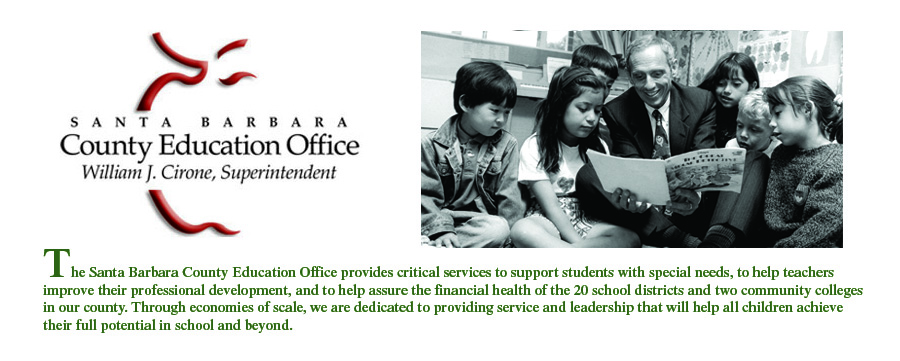News release
“I am very humbled to be a part of a family
of teachers, students, and parents working together to embark on a voyage into
the future of a child’s education. I am still as energized as I was in my
beginning years of teaching, and I still feel that drive to be the best teacher
that I can be.” – Michelle
Minetti-Smith
 |
| Michelle Minetti-Smith |
The Santa Barbara
County Education Office is pleased to announce that Michelle Minetti-Smith, a
first grade teacher at Mary Buren Elementary School in the Guadalupe Union
School District, has been named the 2017 Santa Barbara County Teacher of the Year. Mrs. Minetti-Smith is in her 20th
year of teaching at Mary Buren.
Not only is teaching
“in the genes” for Minetti-Smith; so, too, is the very building in which she
works. “My grandmother taught here for 20 years,” she says. “And Mrs. Buren”—after
whom the school site was eventually named—“was my fifth grade teacher. I was
the fourth generation to attend this school,” she says proudly. She also
hastens to add that she is delighted to still be in touch with her former
fifth-grade teacher, who turned 100 last year.
“There is a very
special quality about Michelle’s story that we are delighted to celebrate,”
says County Superintendent of Schools Bill Cirone. Cirone introduced
Minetti-Smith as the county’s newest Teacher of the Year at their monthly board
meeting Thursday afternoon.
“She takes the idea
of ‘home-grown talent’ to a new level,” Cirone continued. “Her family’s deep
generational ties to the community in which she serves is just one of the
motivators behind her persistent demonstration of excellence. Few know better
than Michelle the importance of making a difference in our community. She truly
walks the talk.”
“Our teachers serve
over 67,000 students in 20 school districts,” Cirone concluded. “Being
selected Teacher of the Year — and representing all the fine teachers
throughout Santa Barbara County — is a tremendous honor. We are
delighted to count Michelle Minetti-Smith among our ranks of
great educators.”
Minetti-Smith was
just one of a number of exceptional nominees for Teacher of the Year
honors. She was selected after a comprehensive review
process conducted by a five-person committee. The committee consisted
of administrators, local business leaders, and last year’s Teacher
of the Year, Canalino Elementary teacher Brandon Sportel.
She will become
the county’s designated representative on July 1, when she succeeds
Sportel as Teacher of the Year, and her nomination for consideration
as California’s Teacher of the Year will begin sometime in the fall of
2016. The state winner will then move forward in the competition
for 2017 National Teacher of the Year.
Minetti-Smith, who
graduated from Fresno State in 1996, knew from an early age that she wanted to
be a teacher, following in the footsteps of her late grandmother. “I had a
couple of job offers in Fresno once I graduated,” she says, “but I wanted to
come home.”
Upon her return, she
submitted her resume to the district office in the hopes they would soon be
hiring. A week later she was called in for an interview with her former elementary
principal, Mr. Jose Nichols. The job ad was for a bilingual teacher. “The panel
was very surprised when I began answering them fluently in Spanish,” she says.
She got a job offer that afternoon.
“I was so humbled
when, at his retirement dinner, Mr. Nichols told a room full of people that one
of his greatest accomplishments was having me come back to our school, fully
bilingual and able to teach in Spanish. Education has opened so many doors for
me,” she says, “and I hope the education that my students receive in my class
will be a step in the path to many doors being opened throughout their lifetime
as well.”
Minetti-Smith’s
recognition is just the latest in a succession of high-profile successes for
Mary Buren. Last spring, the Ellen DeGeneres Show and Target donated $100,000
to the school’s library, which had been destroyed in flooding the year prior.
HGTV crew-members followed up later with some special, signature touches.
“I remember as a kid
going to the Guadalupe City Library to browse the bookshelf or to listen to
Mrs. Villegas, the librarian, share some of her favorite stories,”
Minetti-Smith says. “I’m so delighted that our kids have such a special,
inviting space—right inside our own school—that encourages them to develop a
love of books and reading.”
But it takes more
than just a nice building, as Guadalupe Superintendent Ed Cora knows well. It’s
people.
“In every sense of
the word ‘caring,’ Michelle goes above and beyond to see that others’ needs are
met,” Cora says. “She is truly a rare gem, and our school community is
fortunate to be the benefactor.”
Michelle will also
be recognized at the May 26 Education Celebration event held in Buellton, and
will be highlighted at the November 5 “A Salute to Teachers” gala in Santa
Barbara, held in partnership with Cox.
“I believe teachers
need to be ambassadors for education and do their part in educating the public
about the great things that are happening in our schools and our districts,”
Minetti-Smith says. Her being named Santa Barbara County Teacher of the Year
provides just the opportunity to fulfill that ambassadorial role.
As
Santa Barbara County Teacher of the Year, Minetti-Smith will
be available to speak countywide. He can be reached at 684-4141, or by
calling Steven Keithley, Director of Teacher Programs and Support for
the Santa Barbara County Education Office at
964-4710, ext. 5281.


